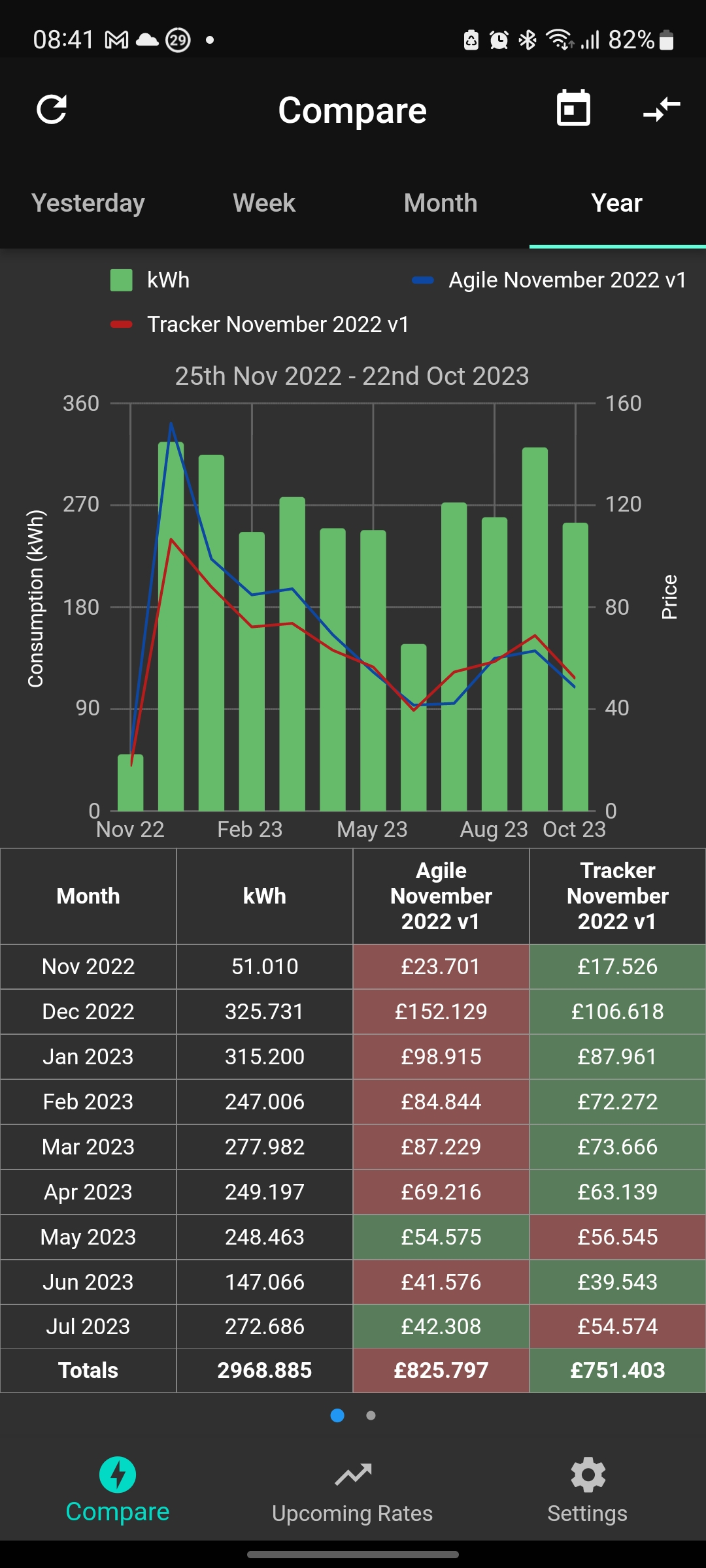We’d like to remind Forumites to please avoid political debate on the Forum.
This is to keep it a safe and useful space for MoneySaving discussions. Threads that are – or become – political in nature may be removed in line with the Forum’s rules. Thank you for your understanding.
The MSE Forum Team would like to wish you all a Merry Christmas. However, we know this time of year can be difficult for some. If you're struggling during the festive period, here's a list of organisations that might be able to help
📨 Have you signed up to the Forum's new Email Digest yet? Get a selection of trending threads sent straight to your inbox daily, weekly or monthly!
Has MSE helped you to save or reclaim money this year? Share your 2025 MoneySaving success stories!
Octopus Tracker
Comments
-
Provided the user has enabled half hourly reads, the comparison should be correct.
0 -
This underlines my query about using the software for less exotic tariffs than AgileTelegraph Sam
There are also unknown unknowns - the one's we don't know we don't know0 -
I do find it quite amusing people panicking over rises in the Tracker. What happened last year during December was historic and highly irregular. It never happened like that before and would be unlikely to happen againspot1034 said:Last year was unusual in that we had a quite significant but short lived cold spell at the end of November and the first half of December. The rest of the season was milder than average.
There is no guarantee that this will be repeated - in fact statistically this is quite unlikely. The coldest weather usually doesn't kick in that early, and is typically seen in the first three months of the new year. If we had three months (or more) of cold the rates would be likely to reflect this, and if this was combined with further and perhaps escalating tension in the world's trouble spots (thus threatening the supply of oil and gas in the months to follow), this would do nothing to stop rates climbing higher than they did last year.
Prices were already rising a bit due to many economic factors we never saw before but also because of Putins war with the West via Gas, We're much more savvy this time round, we're more energy independent and we've stored ahead of time.
Could the tracker go above SVR? Sure, but it would be brief, no more than a few days and nothing like what we saw a year ago.
I highly doubt were going to see this again:
I've looked back 10 years and it always been flat like it has been for the past 9 months. The Gas Market got a bit jittery because of the Israeli/Palastain war breaking out. But after a few days, it always settles down a bit.0 -
= my point about taking long term averages.
What did you use to create that graph?Telegraph Sam
There are also unknown unknowns - the one's we don't know we don't know0 -
https://energy-stats.uk/octopus-tracker-london/Telegraph_Sam said:= my point about taking long term averages.
What did you use to create that graph?
And look at 5 and 10 year history here:
https://tradingeconomics.com/commodity/uk-natural-gas
1 -
I was on Agile up until this morning, I've now been moved to Tracker which I will likely stay on until March.Pat38493 said:
Which tariff are you actually on?Spies said: This is what it suggests I've saved over the course of a year, which isn't as much as I would have thought! 4.29kWp Solar system, 45/55 South/West split in cloudy rainy Cumbria.1
This is what it suggests I've saved over the course of a year, which isn't as much as I would have thought! 4.29kWp Solar system, 45/55 South/West split in cloudy rainy Cumbria.1 -
I think it is valuable to have a spell on Agile to really understand what is achievable in terms of load shifting. That's where I started before moving to Tracker, so knew how my usage would measure up between the two.Comparing the pricing formulae is also valuable - as others have pointed out, Tracker becomes relatively (to Agile) cheaper as wholesale prices rise.2
-
Bendo said:Provided the user has enabled half hourly reads, the comparison should be correct.Yes, the comparison between what you are currently using half hour by half hour in Tracker and what it would be for the exact same half hour by half use if you were using Agile should be correct.The question is how meaningful or useful is that comparison?The main advantage (whole point?) of Agile is that you are charged different amounts at different times of day.Doing things like using the delay timer on your washing machine so it runs overnight or in the early afternoon instead of the evening you can make a big difference to your bill. On a given day it wouldn't be unusual for, say, the Tracker price to be 20p/kWh all day and the Agile price to vary between 15p/kWh overnight and in the eraly afternoon or 45p/kWh during the evening peak.Let's suppose you're currently on Tracker and normally do your laundry in the evening peak because that's the most convenient time for you, and let's assume for the point of simplicity you use 1kWh of energy to do that. Using the above figures that would cost 20p.If you were to move to Agile, you could choose to do the laundry at the same time in which case it would cost 45p, or use the timer to do it overnight or in the early afternoon at a cost of 15p. This leads to a very different comparison - in one case Tracker is 2.5 times the price of Agile - in the other it is 25% less. So if you're trying to work out which tariff is best for you which depends on how you're going to use Agile and the potential and practicality of doing things to take advantage of the best rates. There's no right or wrong answer here - you just need to do whatever comparison is appropriate to you, and there's more to this than just plugging in your existing Tracker (or any other non-Agile) tariff data.The meaningful comparison is with what you would do if you were on Agile which for many (most?) people is (or should be) likely to be different to what they're doing now. Otherwise there's very little reason to switch to Agile.Hope this makes sense?2
-
are these not the same thing then:
https://tradingeconomics.com/commodity/uk-natural-gas
https://www.bbc.co.uk/news/topics/cxwdwz5d8gxt
edit: actually i now see the word "futures" in the BBC link. i am quite sure at one point these figures were the same.0 -
Relatively 'cheap' electricity tomorrow - for me, 14.16p/kWh0
Confirm your email address to Create Threads and Reply

Categories
- All Categories
- 352.9K Banking & Borrowing
- 253.9K Reduce Debt & Boost Income
- 454.7K Spending & Discounts
- 246K Work, Benefits & Business
- 602.1K Mortgages, Homes & Bills
- 177.8K Life & Family
- 259.9K Travel & Transport
- 1.5M Hobbies & Leisure
- 16K Discuss & Feedback
- 37.7K Read-Only Boards







